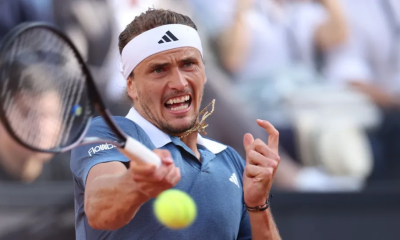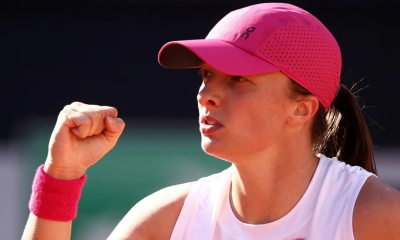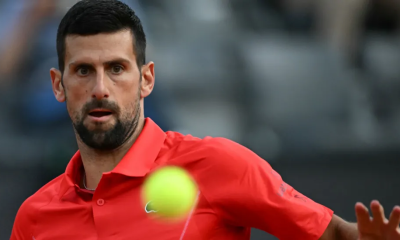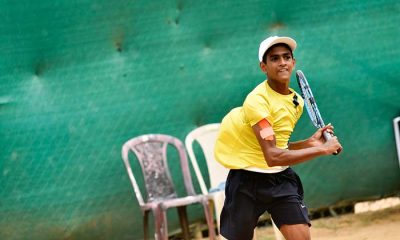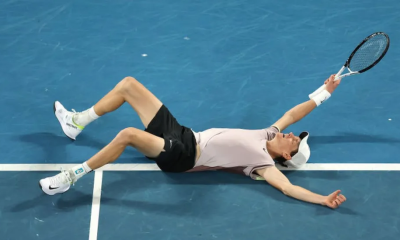Features
TENNIS LOSES FEDERER HOMAGE TO A GENIUS
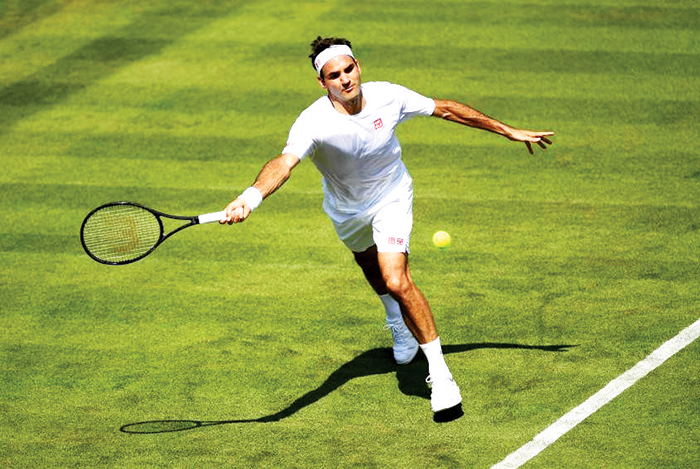
By Anura Gunasekera
Roger Federer, the most celebrated Tennis player in history, after an illustrious two-decade career, departs the arena he graced with such virtuosity. Over an improbably long period he dominated in the most star-studded period of professional Tennis, unarguably that which showcased the greatest depth of talent of any era.
Federer concedes his mortality with the same dignity and equanimity, with which he has greeted both victory and defeat, the defining features of his public conduct over the years. It has been a stellar display, definable only in superlatives – even at the risk of sounding mawkish. Ideally, instead of this gradual fade-out, loyal fans would have cherished a more spectacular finale, a dream farewell, but sport is cruelly indifferent, even to its icons.
Like all greats who enforce change on their domain, Federer imposed his writ on his sport. To match his authority, delivered with silken skill , he forced rivals to improvise, restructure, to reach in to unsuspected depths and , in the process, to uplift their own competencies. That the top twenty in the last two decades, Roddick, Nadal, Djockovic, Murray, Wawrinka , Berdych and Hewitt included, became the players that they are, is in large measure due to the excellence and the challenge Federer presented. Had he not been around, his opponents would have been lesser players, lesser men.
In a sport which was subsiding in to constant, tedious contests, amongst a group of lusty base-line hitters with massive forehands and looping double-fisted backhands, Federer re-conjured a vanished finesse; the beauty of all-court shot-making, comprising a captivating mix of serve and volley, mid-court aggression and delicate passing shots, threading invisible gaps with surgical precision, reinforced by dexterous serving and solid back-court play.
Shot-for-shot, in the bread-and-butter armoury of all good Tennis players, through all his playing years Federer was superseded in consistency and power, by most of his close rivals. In an era when 200 kmph serves are a commonality, in terms of speed Federer was unexceptional. One could easily name a dozen players, some of them not even in the top hundred, who would out-gun the maestro on a given day. Yet, in terms of total career aces, Federer is third in the list, not far behind the two giant artillerymen, Isner and Karlovich.
When talking of powerful single-handed backhands, the names that come to mind are Wawrinka, Gasquet and, latterly, Thiem, Tsitsipas and Shapovalov. Federer is not the natural first. Forehands were delivered with greater power and consistency, by Del Potro, Djockovic, Nadal, Berdych, Verdasco and a host of other, lesser players. Amongst the top ten serve-volley specialists of the last three decades, Federer rates an honourable mention, but pundits would not rank him above Cash, McEnroe, Edberg, Sampras, Becker, Stitch or even Henman. His return of serve was reliable but rarely exceptional, mostly a neutral shot to ease him in to the point. In that department he will not be rated above Agassi, Nadal, Murray, Djokovic or Hewitt.
Given the superiority of all those players in specific aspects of the game, what enabled Federer’s lengthy dominance over a host of rivals, with individual weapons bigger than anything in his arsenal?
One can talk of Federer’s court coverage, a dance choreographed personally by the master, feathery light on his feet, an exhibition of fluid, balletic grace; the unreadable serve, delivered with identical action, whether down the centre or nicking the side lines; the back-hand down the line, its classic beauty masking the raw power; the topspin, back-hand cross-court flick, from deep in the ad-court, defying the mechanical limitations on shot-making and conjuring angles a double-fisted hitter would envy; the flat, rocketing, off-forehand, delivered at full stretch, described by John McEnroe, a genius of an earlier era, as the “greatest shot in our sport”; the running passes on both wings; the reflex volleys from mid-court and the overhead smashes with feet three feet off the ground, the backhand smash and the “tweener”.
Perhaps it was all of these, combined with the freshness that he brought to the game, the elegant all-court artistry, beguilingly creative, its freedom of expression defying the fear of error percentages , confident that the winners would eventually override the errors; a magical shot-making, his racquet a fencer’s foil, probing chinks in the opponent’s armour.
His brilliance is captured by McEnroe, commentating at Wimbledon a few years ago; from his deuce court Federer delivers an explosive backhand return winner, against a massive first serve, the ball nicking the side- line of the opponent’s service box, and McEnroe declaims in awed tones, “that shot does not exist, It Does Not Exist !!!” Federer made the impossible look both casual and natural, persuading the spectator that genius was a universally attainable goal.
Yet, this audacity , with minimal margin for error, was constantly shadowed by the likelihood of failure, particularly against more conservative opponents. Some of Federer’s significant losses are attributable to the high-risk nature of his game. But it was also his vulnerability, which enthralled and kept the audience on edge, all the time.
Federer had no formula, unlike the more calculating Djockovic , who relied on the metronomic precision of repetitive shot-making , with minimal variation from the first to the last stroke, even in a forty-shot rally; or Nadal, the man who troubled Federer the most, shackling opponents with relentless, top-spin, baseline bludgeoning ; or the choleric, unhappy, Murray, scrambling from side-to-side like a terrier, constantly at war with himself, his impregnable defence more effective than his attack. In stark contrast to all his peers, Federer in full flow was a joyous exhibition of spontaneity and improvisation.
Federer’s genius was summed up best by a great of a different era, Jimmy Connors, who once said, “in an era of specialists you are either a clay court specialist, a grass court specialist, a hard court specialist…..or you are Roger Federer “.
How does one define greatness in sport? Statistics, of course, are a prime consideration. Federer has 20 Major Singles titles in his cupboard, surpassed recently by both Nadal and Djokovic. He has figured in some of the most scintillating duels in the history of Tennis, most of which he has won. The only warp in a glittering tapestry is his record against Nadal who, as the Aussies would say, had the “wood on him”. But that too has to be viewed in context. In 40 encounters, of the 24-16 tally in Nadal’s favour, 14 of Federer’s losses are on clay, a surface on which Nadal, unarguably, has no peer. On the faster surfaces Federer leads, 19-11.
Federer’s supremacy fostered magnificent rivalries which enriched tennis of his period, in a manner not seen in any previous era. Apart from Nadal, against Djokovic it is 27-23 in favour of the Serb with the rigidly structured game, 23-3 against Wawrinka, 14-11 against Murray and 17-6 against Berdych. Against Roddick, who himself said that given Federer’s 21-3 dominance that there was no rivalry , 18-9 against Hewitt and 15-5 against the giant Del Potro; reaching further back when Federer was yet to cement his superiority, it is 11-8 against both Safin and Nalbandian and 8-3 with Agassi .
Federer’s supreme individualism does not leave a legacy for new entrants to inherit. Rigidly structured playing styles, which regularly produce thousands of clones in tennis courts the world over, are based on predetermined formulae, supported by proven results and easily passed on from coach or academy to aspiring players. In the universal context of production-line tennis, Federer’s talent was a radiant aberration. Out on the court Federer wrote a script birthed in his own psyche.
What of Roger Federer , the man? Great athletes tend to be viewed only in the context of the discipline that they dominate. Similarly, Federer the man is largely obscured by Federer the tennis player, with his involvement in and contribution to worthy causes rarely reaching the public eye. There is the Roger Federer Foundation for disadvantaged children, totally funded by him, and its affiliation with the South Africa – Swiss Charity, IMBEWU, to assist disadvantaged African children in sports, social and health awareness. In addition there is the leadership he has provided, through numerous sporting events, to generate funds for disaster victims all over the world. Federer, clearly, is a rare synthesis of sporting greatness and civic goodness.
Federer is also the only athlete of the Open era, to combine an obviously busy family life with that of being a world top five player. In an unrelentingly demanding sport, which precludes distractions outside the game, Federer is clearly a dedicated family man at the head of a large and loving family. This sense of proportion and balance, the awareness of the transient nature of supremacy in a sport, and the active contribution to a greater calling outside that dominance, invests Federer’s persona with a completeness, that no other great of the game has demonstrated in his playing days.
The “Greatest of All Time” (GOAT) debate needs mention, even briefly, in any dialogue involving Federer, Nadal and Djokovic. The Serb, with his growing collection of majors, may finally be defined, statistically, as the best craftsman of all time whilst the Spaniard, with his tenacity and physicality, is already spoken of as the toughest opponent of the Open era. However, greatness embraces multiple dimensions. For instance, It cannot admit the international embarrassment that Djokovic is, today. Greatness is a composite of longevity and successful outcomes, reinforced by visual beauty, lethalness of delivery, impeccable conduct, charisma, and the respect accorded by society. It is as much about style and manner of execution, and influence outside the sport, as it is about win-loss statistics.
Federer’s on-court conduct was invariably civil and understated, untainted by the often embarrassingly theatrical bellicosity and provocative histrionics of some of the other stars. That timeless grace extended beyond the court and inhabited his public persona as well. He is still the superstar of Tennis, continuing to transcend the sport despite the decline of his on-court dominance. In the Open Era, no other player has impacted the game as beneficially, as Federer has done. The retirement of no other tennis player has evoked such universal regret, acclaim and tributes, especially from former opponents and fellow contestants. Given all those elements, Federer, the supreme aristocrat of Tennis, wins the GOAT contest, hands down. Federer was the greatest, in a time of greats.
Federer’s career was akin to a glowing comet traversing the Tennis galaxy. Sadly, whilst other galactic wayfarers return at predictable intervals, this is one stellar being who is destined to disappear in to the sun. There will be no heir because he leaves behind no mould for recasting. What a bereaved Tennis world is left with is an enduring legacy of displays of genius, of consummate artistry, unique to the man. The statistics of his dominance will always be available for analysis but the elegance, the grace, and the unimpeachable conduct, both on and off the court, must remain enshrined in collective memory, particularly for those fortunate enough to have witnessed the peerless athlete in his prime.
Features
The heart-friendly health minister

by Dr Gotabhya Ranasinghe
Senior Consultant Cardiologist
National Hospital Sri Lanka
When we sought a meeting with Hon Dr. Ramesh Pathirana, Minister of Health, he graciously cleared his busy schedule to accommodate us. Renowned for his attentive listening and deep understanding, Minister Pathirana is dedicated to advancing the health sector. His openness and transparency exemplify the qualities of an exemplary politician and minister.
Dr. Palitha Mahipala, the current Health Secretary, demonstrates both commendable enthusiasm and unwavering support. This combination of attributes makes him a highly compatible colleague for the esteemed Minister of Health.
Our discussion centered on a project that has been in the works for the past 30 years, one that no other minister had managed to advance.
Minister Pathirana, however, recognized the project’s significance and its potential to revolutionize care for heart patients.
The project involves the construction of a state-of-the-art facility at the premises of the National Hospital Colombo. The project’s location within the premises of the National Hospital underscores its importance and relevance to the healthcare infrastructure of the nation.
This facility will include a cardiology building and a tertiary care center, equipped with the latest technology to handle and treat all types of heart-related conditions and surgeries.
Securing funding was a major milestone for this initiative. Minister Pathirana successfully obtained approval for a $40 billion loan from the Asian Development Bank. With the funding in place, the foundation stone is scheduled to be laid in September this year, and construction will begin in January 2025.
This project guarantees a consistent and uninterrupted supply of stents and related medications for heart patients. As a result, patients will have timely access to essential medical supplies during their treatment and recovery. By securing these critical resources, the project aims to enhance patient outcomes, minimize treatment delays, and maintain the highest standards of cardiac care.
Upon its fruition, this monumental building will serve as a beacon of hope and healing, symbolizing the unwavering dedication to improving patient outcomes and fostering a healthier society.We anticipate a future marked by significant progress and positive outcomes in Sri Lanka’s cardiovascular treatment landscape within the foreseeable timeframe.
Features
A LOVING TRIBUTE TO JESUIT FR. ALOYSIUS PIERIS ON HIS 90th BIRTHDAY

by Fr. Emmanuel Fernando, OMI
Jesuit Fr. Aloysius Pieris (affectionately called Fr. Aloy) celebrated his 90th birthday on April 9, 2024 and I, as the editor of our Oblate Journal, THE MISSIONARY OBLATE had gone to press by that time. Immediately I decided to publish an article, appreciating the untiring selfless services he continues to offer for inter-Faith dialogue, the renewal of the Catholic Church, his concern for the poor and the suffering Sri Lankan masses and to me, the present writer.
It was in 1988, when I was appointed Director of the Oblate Scholastics at Ampitiya by the then Oblate Provincial Fr. Anselm Silva, that I came to know Fr. Aloy more closely. Knowing well his expertise in matters spiritual, theological, Indological and pastoral, and with the collaborative spirit of my companion-formators, our Oblate Scholastics were sent to Tulana, the Research and Encounter Centre, Kelaniya, of which he is the Founder-Director, for ‘exposure-programmes’ on matters spiritual, biblical, theological and pastoral. Some of these dimensions according to my view and that of my companion-formators, were not available at the National Seminary, Ampitiya.
Ever since that time, our Oblate formators/ accompaniers at the Oblate Scholasticate, Ampitiya , have continued to send our Oblate Scholastics to Tulana Centre for deepening their insights and convictions regarding matters needed to serve the people in today’s context. Fr. Aloy also had tried very enthusiastically with the Oblate team headed by Frs. Oswald Firth and Clement Waidyasekara to begin a Theologate, directed by the Religious Congregations in Sri Lanka, for the contextual formation/ accompaniment of their members. It should very well be a desired goal of the Leaders / Provincials of the Religious Congregations.
Besides being a formator/accompanier at the Oblate Scholasticate, I was entrusted also with the task of editing and publishing our Oblate journal, ‘The Missionary Oblate’. To maintain the quality of the journal I continue to depend on Fr. Aloy for his thought-provoking and stimulating articles on Biblical Spirituality, Biblical Theology and Ecclesiology. I am very grateful to him for his generous assistance. Of late, his writings on renewal of the Church, initiated by Pope St. John XX111 and continued by Pope Francis through the Synodal path, published in our Oblate journal, enable our readers to focus their attention also on the needed renewal in the Catholic Church in Sri Lanka. Fr. Aloy appreciated very much the Synodal path adopted by the Jesuit Pope Francis for the renewal of the Church, rooted very much on prayerful discernment. In my Religious and presbyteral life, Fr.Aloy continues to be my spiritual animator / guide and ongoing formator / acccompanier.
Fr. Aloysius Pieris, BA Hons (Lond), LPh (SHC, India), STL (PFT, Naples), PhD (SLU/VC), ThD (Tilburg), D.Ltt (KU), has been one of the eminent Asian theologians well recognized internationally and one who has lectured and held visiting chairs in many universities both in the West and in the East. Many members of Religious Congregations from Asian countries have benefited from his lectures and guidance in the East Asian Pastoral Institute (EAPI) in Manila, Philippines. He had been a Theologian consulted by the Federation of Asian Bishops’ Conferences for many years. During his professorship at the Gregorian University in Rome, he was called to be a member of a special group of advisers on other religions consulted by Pope Paul VI.
Fr. Aloy is the author of more than 30 books and well over 500 Research Papers. Some of his books and articles have been translated and published in several countries. Among those books, one can find the following: 1) The Genesis of an Asian Theology of Liberation (An Autobiographical Excursus on the Art of Theologising in Asia, 2) An Asian Theology of Liberation, 3) Providential Timeliness of Vatican 11 (a long-overdue halt to a scandalous millennium, 4) Give Vatican 11 a chance, 5) Leadership in the Church, 6) Relishing our faith in working for justice (Themes for study and discussion), 7) A Message meant mainly, not exclusively for Jesuits (Background information necessary for helping Francis renew the Church), 8) Lent in Lanka (Reflections and Resolutions, 9) Love meets wisdom (A Christian Experience of Buddhism, 10) Fire and Water 11) God’s Reign for God’s poor, 12) Our Unhiddden Agenda (How we Jesuits work, pray and form our men). He is also the Editor of two journals, Vagdevi, Journal of Religious Reflection and Dialogue, New Series.
Fr. Aloy has a BA in Pali and Sanskrit from the University of London and a Ph.D in Buddhist Philosophy from the University of Sri Lankan, Vidyodaya Campus. On Nov. 23, 2019, he was awarded the prestigious honorary Doctorate of Literature (D.Litt) by the Chancellor of the University of Kelaniya, the Most Venerable Welamitiyawe Dharmakirthi Sri Kusala Dhamma Thera.
Fr. Aloy continues to be a promoter of Gospel values and virtues. Justice as a constitutive dimension of love and social concern for the downtrodden masses are very much noted in his life and work. He had very much appreciated the commitment of the late Fr. Joseph (Joe) Fernando, the National Director of the Social and Economic Centre (SEDEC) for the poor.
In Sri Lanka, a few religious Congregations – the Good Shepherd Sisters, the Christian Brothers, the Marist Brothers and the Oblates – have invited him to animate their members especially during their Provincial Congresses, Chapters and International Conferences. The mainline Christian Churches also have sought his advice and followed his seminars. I, for one, regret very much, that the Sri Lankan authorities of the Catholic Church –today’s Hierarchy—- have not sought Fr.
Aloy’s expertise for the renewal of the Catholic Church in Sri Lanka and thus have not benefited from the immense store of wisdom and insight that he can offer to our local Church while the Sri Lankan bishops who governed the Catholic church in the immediate aftermath of the Second Vatican Council (Edmund Fernando OMI, Anthony de Saram, Leo Nanayakkara OSB, Frank Marcus Fernando, Paul Perera,) visited him and consulted him on many matters. Among the Tamil Bishops, Bishop Rayappu Joseph was keeping close contact with him and Bishop J. Deogupillai hosted him and his team visiting him after the horrible Black July massacre of Tamils.
Features
A fairy tale, success or debacle

Sri Lanka-Singapore Free Trade Agreement
By Gomi Senadhira
senadhiragomi@gmail.com
“You might tell fairy tales, but the progress of a country cannot be achieved through such narratives. A country cannot be developed by making false promises. The country moved backward because of the electoral promises made by political parties throughout time. We have witnessed that the ultimate result of this is the country becoming bankrupt. Unfortunately, many segments of the population have not come to realize this yet.” – President Ranil Wickremesinghe, 2024 Budget speech
Any Sri Lankan would agree with the above words of President Wickremesinghe on the false promises our politicians and officials make and the fairy tales they narrate which bankrupted this country. So, to understand this, let’s look at one such fairy tale with lots of false promises; Ranil Wickremesinghe’s greatest achievement in the area of international trade and investment promotion during the Yahapalana period, Sri Lanka-Singapore Free Trade Agreement (SLSFTA).
It is appropriate and timely to do it now as Finance Minister Wickremesinghe has just presented to parliament a bill on the National Policy on Economic Transformation which includes the establishment of an Office for International Trade and the Sri Lanka Institute of Economics and International Trade.
Was SLSFTA a “Cleverly negotiated Free Trade Agreement” as stated by the (former) Minister of Development Strategies and International Trade Malik Samarawickrama during the Parliamentary Debate on the SLSFTA in July 2018, or a colossal blunder covered up with lies, false promises, and fairy tales? After SLSFTA was signed there were a number of fairy tales published on this agreement by the Ministry of Development Strategies and International, Institute of Policy Studies, and others.
However, for this article, I would like to limit my comments to the speech by Minister Samarawickrama during the Parliamentary Debate, and the two most important areas in the agreement which were covered up with lies, fairy tales, and false promises, namely: revenue loss for Sri Lanka and Investment from Singapore. On the other important area, “Waste products dumping” I do not want to comment here as I have written extensively on the issue.
1. The revenue loss
During the Parliamentary Debate in July 2018, Minister Samarawickrama stated “…. let me reiterate that this FTA with Singapore has been very cleverly negotiated by us…. The liberalisation programme under this FTA has been carefully designed to have the least impact on domestic industry and revenue collection. We have included all revenue sensitive items in the negative list of items which will not be subject to removal of tariff. Therefore, 97.8% revenue from Customs duty is protected. Our tariff liberalisation will take place over a period of 12-15 years! In fact, the revenue earned through tariffs on goods imported from Singapore last year was Rs. 35 billion.
The revenue loss for over the next 15 years due to the FTA is only Rs. 733 million– which when annualised, on average, is just Rs. 51 million. That is just 0.14% per year! So anyone who claims the Singapore FTA causes revenue loss to the Government cannot do basic arithmetic! Mr. Speaker, in conclusion, I call on my fellow members of this House – don’t mislead the public with baseless criticism that is not grounded in facts. Don’t look at petty politics and use these issues for your own political survival.”
I was surprised to read the minister’s speech because an article published in January 2018 in “The Straits Times“, based on information released by the Singaporean Negotiators stated, “…. With the FTA, tariff savings for Singapore exports are estimated to hit $10 million annually“.
As the annual tariff savings (that is the revenue loss for Sri Lanka) calculated by the Singaporean Negotiators, Singaporean $ 10 million (Sri Lankan rupees 1,200 million in 2018) was way above the rupees’ 733 million revenue loss for 15 years estimated by the Sri Lankan negotiators, it was clear to any observer that one of the parties to the agreement had not done the basic arithmetic!
Six years later, according to a report published by “The Morning” newspaper, speaking at the Committee on Public Finance (COPF) on 7th May 2024, Mr Samarawickrama’s chief trade negotiator K.J. Weerasinghehad had admitted “…. that forecasted revenue loss for the Government of Sri Lanka through the Singapore FTA is Rs. 450 million in 2023 and Rs. 1.3 billion in 2024.”
If these numbers are correct, as tariff liberalisation under the SLSFTA has just started, we will pass Rs 2 billion very soon. Then, the question is how Sri Lanka’s trade negotiators made such a colossal blunder. Didn’t they do their basic arithmetic? If they didn’t know how to do basic arithmetic they should have at least done their basic readings. For example, the headline of the article published in The Straits Times in January 2018 was “Singapore, Sri Lanka sign FTA, annual savings of $10m expected”.
Anyway, as Sri Lanka’s chief negotiator reiterated at the COPF meeting that “…. since 99% of the tariffs in Singapore have zero rates of duty, Sri Lanka has agreed on 80% tariff liberalisation over a period of 15 years while expecting Singapore investments to address the imbalance in trade,” let’s turn towards investment.
Investment from Singapore
In July 2018, speaking during the Parliamentary Debate on the FTA this is what Minister Malik Samarawickrama stated on investment from Singapore, “Already, thanks to this FTA, in just the past two-and-a-half months since the agreement came into effect we have received a proposal from Singapore for investment amounting to $ 14.8 billion in an oil refinery for export of petroleum products. In addition, we have proposals for a steel manufacturing plant for exports ($ 1 billion investment), flour milling plant ($ 50 million), sugar refinery ($ 200 million). This adds up to more than $ 16.05 billion in the pipeline on these projects alone.
And all of these projects will create thousands of more jobs for our people. In principle approval has already been granted by the BOI and the investors are awaiting the release of land the environmental approvals to commence the project.
I request the Opposition and those with vested interests to change their narrow-minded thinking and join us to develop our country. We must always look at what is best for the whole community, not just the few who may oppose. We owe it to our people to courageously take decisions that will change their lives for the better.”
According to the media report I quoted earlier, speaking at the Committee on Public Finance (COPF) Chief Negotiator Weerasinghe has admitted that Sri Lanka was not happy with overall Singapore investments that have come in the past few years in return for the trade liberalisation under the Singapore-Sri Lanka Free Trade Agreement. He has added that between 2021 and 2023 the total investment from Singapore had been around $162 million!
What happened to those projects worth $16 billion negotiated, thanks to the SLSFTA, in just the two-and-a-half months after the agreement came into effect and approved by the BOI? I do not know about the steel manufacturing plant for exports ($ 1 billion investment), flour milling plant ($ 50 million) and sugar refinery ($ 200 million).
However, story of the multibillion-dollar investment in the Petroleum Refinery unfolded in a manner that would qualify it as the best fairy tale with false promises presented by our politicians and the officials, prior to 2019 elections.
Though many Sri Lankans got to know, through the media which repeatedly highlighted a plethora of issues surrounding the project and the questionable credentials of the Singaporean investor, the construction work on the Mirrijiwela Oil Refinery along with the cement factory began on the24th of March 2019 with a bang and Minister Ranil Wickremesinghe and his ministers along with the foreign and local dignitaries laid the foundation stones.
That was few months before the 2019 Presidential elections. Inaugurating the construction work Prime Minister Ranil Wickremesinghe said the projects will create thousands of job opportunities in the area and surrounding districts.
The oil refinery, which was to be built over 200 acres of land, with the capacity to refine 200,000 barrels of crude oil per day, was to generate US$7 billion of exports and create 1,500 direct and 3,000 indirect jobs. The construction of the refinery was to be completed in 44 months. Four years later, in August 2023 the Cabinet of Ministers approved the proposal presented by President Ranil Wickremesinghe to cancel the agreement with the investors of the refinery as the project has not been implemented! Can they explain to the country how much money was wasted to produce that fairy tale?
It is obvious that the President, ministers, and officials had made huge blunders and had deliberately misled the public and the parliament on the revenue loss and potential investment from SLSFTA with fairy tales and false promises.
As the president himself said, a country cannot be developed by making false promises or with fairy tales and these false promises and fairy tales had bankrupted the country. “Unfortunately, many segments of the population have not come to realize this yet”.
(The writer, a specialist and an activist on trade and development issues . )


